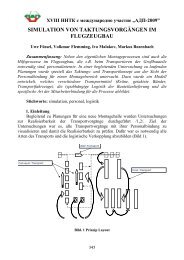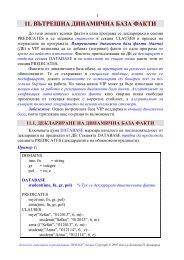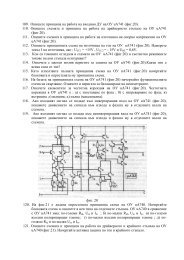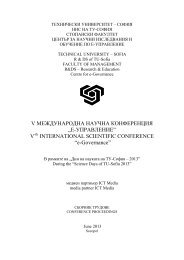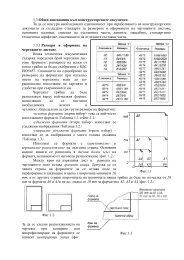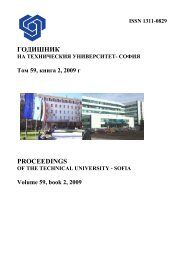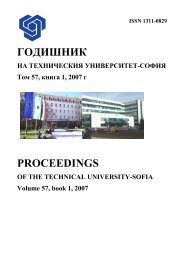Volume 61 Issue 2 (2011) - Годишник на ТУ - София - Технически ...
Volume 61 Issue 2 (2011) - Годишник на ТУ - София - Технически ...
Volume 61 Issue 2 (2011) - Годишник на ТУ - София - Технически ...
- No tags were found...
You also want an ePaper? Increase the reach of your titles
YUMPU automatically turns print PDFs into web optimized ePapers that Google loves.
However, the correlation between results of thermal analysis - TG (DTG), DTA andDSC, and the real fire behavior of wood was not established yet, [13]. Usually thethermal analysis is carried out at thermodynamically stable equilibrium, i.e. thetemperature rate below to the 410 0 C/min range. The real fire reach the flashover(about 600 0 C) for ten minutes and the relevant heating rate is essentially higher –from 50 to 60 0 C/min. One better approximation to real fire might be a thermalanalysis at increased rate of heating (50 0 C/min) closer to the real fire condition.TG and DTG analysis curves of the above described samples are presented in Fig.2a. The mass loss at all studied samples in the first temperature zone (up to the ignitionpoint) is slight due to a release of a small amount of inflammable volatilesubstances and the differences between the samples indicate their different dehydratationand decomposition.The intense pyrolysis of the non-protected wood sample, Fig. 2a, TG-curve 1, inthe flaming zone (the first after the ignition point) is accompanied with a very sharpmass loss (more than 60 %) due to a formation of a lot of low molecular weightflammable volatile products whereas suppressed flaming and started below ignitionpoint (IP) glowing with coal char formation is visually observed for all flame retardedsamples, Fig. 2a, TG-curves 25, accompanied with less mass loss comparedto the control wood sample. The DBD pre-treatment effect on the flame retardencyfor different operational conditions, Fig.2b, DTG-curves 35 was expressed by theappearance of the main peak at lower temperatures (322, 347, 350 0 C) comparing tothe flame retarded wood sample (365 0 C), i.e. it reinforced the flame retardency effect,in comparison with bare wood (411 0 C). The formation of protective barrierchar layer started earlier and finished before the flaming start of the bare wood, Fig.2b. This DBD pre-treatment effect attended with a well expressed growth of theloss of mass compared to the bare wood. The built char barrier (in temperature zoneA) retarded the loss of mass of flame retarded samples after 426430 0 C (zone B),Fig. 3. The total mass loss at the 600 0 C of DBD-aided flame retarded samples was52, 55 % for low and 66 % for high frequency DBD, against 58 % for flame retardedwood samples and 71 % for bare wood.DSC and DTA curves of the flame retarded wood, Fig. 4, curves 25, to that of thebare wood, curve 1, demonstrated significant alterations of the thermal effects andthe head flow in all above described temperature zones indicating in this way thatthe used flame retardant and DBD pre-treatment influenced all steps of the woodpyrolysis and burning.The comparison of curve 2 to curve 1, Fig. 4a, shows: i) a slight shift of the IP tothe higher temperature – from 300 0 C for the bare wood and up to 303350 0 C forthe flame protected one; ii) the appearance of a enlarged endothermic peak at190 0 C for the flame retarded wood evidently is connected to the thermal decompositionof the used flame retardant; iii) the observed for bare wood flaming peak at346 (347) 0 C is suppressed and absorbed by an enlarged charing peak at 433 0 C forflame retarded wood. Such large peak relevant to the building of the protective charbarrier is observed too after the IP at different temperature for DBD pre-treatmentflame retarded wood: 421 and 431 0 C for low and 455 0 C for high frequency DBD.91



